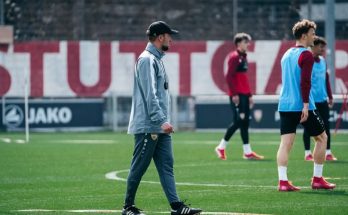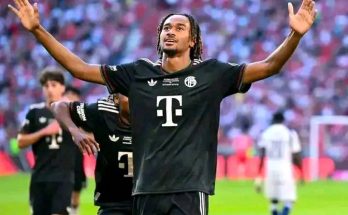On a night meant to define futures, forge legacies, and ignite dreams, history took a strange, uncanny turn. The 2025 NBA Draft delivered its usual surprises, emotional high points, and unforgettable moments. But amid the night’s chaos, one storyline stood out—not because it was unprecedented, but because it felt eerily familiar. Koby Brea, the sharpshooting Dayton guard with a remarkable journey to the big stage, experienced a draft night so shockingly similar to that of former NBA player and current BYU head coach Mark Pope that fans, analysts, and insiders are still trying to make sense of it. From their collegiate paths to their pre-draft buzz and ultimate draft night outcomes, Brea’s and Pope’s stories feel like they’ve been lifted from the same script, just written decades apart. And the more you dig into the parallels, the more bizarre and fascinating it becomes.
Koby Brea entered the 2025 draft as a wild card. Despite being one of the most efficient three-point shooters in the nation and a vital contributor to Dayton’s resurgence as a mid-major power, his draft stock was wildly inconsistent. Some mock drafts had him slipping into the late second round. Others had him going undrafted. He was praised for his intelligence, floor spacing, and maturity, but skeptics questioned his athleticism, his ceiling, and whether his game would translate to the speed and physicality of the NBA.
And then draft night arrived—and unfolded with jaw-dropping déjà vu.
Mark Pope, back in 1996, faced an almost identical trajectory. As a player at Kentucky, Pope wasn’t a flashy name. He wasn’t the most athletic or dynamic on the court, but he was savvy, consistent, and team-first—a big man who knew his role and executed it well. Just like Brea, Pope found himself in the strange limbo of being too good to ignore but not quite fitting the mold of a guaranteed draft pick. He sat through much of the 1996 NBA Draft without hearing his name. His fate hung in the balance for hours.
Then, with one of the final picks, Pope was selected 52nd overall by the Indiana Pacers—a team looking for glue guys, character, and basketball IQ. It wasn’t the most glamorous draft moment, but it was a lifeline into the league. Pope went on to carve out a respectable NBA career, later turning to coaching and becoming one of the most intriguing minds in college basketball.
Fast forward nearly 30 years, and here was Koby Brea, sitting through his own agonizing wait. And when his name finally flashed across the screen late in the second round, it sent social media into a frenzy—not just because he had been picked, but because everything about his draft night mirrored Pope’s. The pick came at No. 52, the exact same spot. The franchise that took him? Ironically, it was the Indiana Pacers again, trading up to grab Brea in a quiet, under-the-radar move that immediately sent NBA Twitter into conspiracy theory mode.
You can’t make this up. Fans began posting side-by-side comparisons. “Mark Pope 1996 = Koby Brea 2025” trended for hours. It wasn’t just the draft slot or the team; it was the vibe. Like Pope, Brea didn’t cry on stage. He didn’t walk across the platform into the commissioner’s arms. He sat with quiet gratitude, eyes locked forward, almost as if he knew he was stepping into a narrative far bigger than just himself.
And then came the kicker: Mark Pope had just taken the BYU head coaching job when Brea was still playing at Dayton, and BYU had, in fact, tried to recruit Brea as a transfer during his collegiate years. Though he chose to stay loyal to Dayton, the connections were undeniable. Pope had admired Brea’s work ethic from afar. Brea had reportedly watched old clips of Pope when studying role players who found a way to contribute at the next level. Two paths, decades apart, crossing in the most mystifying of ways on the NBA’s biggest stage.
It’s rare in sports for such perfect symmetry to occur, but when it does, it becomes the stuff of legend. Think of the countless comparisons between Michael Jordan and Kobe Bryant—not just stylistically but even down to eerily similar in-game moments, final shots, facial expressions. Or consider the near-identical rookie seasons of Luka Dončić and LeBron James. Sometimes, sports feel scripted, like the universe is winking at us through repeated patterns.
In Koby Brea’s case, fans are doing more than noticing—they’re obsessing. Some have even gone so far as to pull out the numbers: Pope’s senior year stats and Brea’s final year at Dayton are strikingly close in terms of efficiency and impact. Both were considered “cerebral players,” both faced doubts about their physicality, and both won over their coaches with consistency and effort rather than eye-popping highlights.
But there’s another layer here. What makes this story even more captivating is the cultural moment we’re in—a time when the NBA is moving faster, louder, and younger. Flashy one-and-dones dominate headlines. Viral highlights overshadow fundamentals. Players like Brea and Pope stand as quiet counterpoints to this chaos. They’re reminders that sometimes the journey matters more than the hype. Sometimes the underdog who waits patiently at pick No. 52 is the one who outlasts the lottery pick. It’s a narrative the league sorely needs, and one the fans crave.
Even more compelling is how Brea’s draft night may serve as inspiration for players coming up in non-blue-blood programs. Dayton isn’t Duke. It’s not Kansas or Kentucky. But Brea’s rise proves that if you stay the course, embrace your role, and grind with humility, you’ll get your shot—even if it comes with a strange historical echo attached.
Mark Pope himself took to social media the morning after the draft, tweeting a simple message: “Some things are bigger than coincidence. Congratulations, Koby. Welcome to the club.” That tweet garnered over 300,000 likes and was retweeted by former players, broadcasters, and even Pacers executives. Whether Pope meant it mystically or just respectfully is unclear. What is clear is that this story has legs—and fans aren’t done marveling at the coincidence.
Now comes the true test for Brea. Can he, like Pope, carve out a sustainable career? Can he become more than just a trivia question—“Who was drafted at No. 52 by the Pacers, just like Mark Pope, three decades later?” Can he take the surreal symmetry of his draft night and turn it into his own legend?
The early signs are promising. Pacers GM Chad Buchanan, when asked about Brea post-draft, said, “We see a guy who knows how to win, who knows his role, and who will work his tail off to earn every minute. That’s a guy we want in our locker room.” Almost word-for-word what Pacers brass said about Pope in 1996.
If Brea’s future mirrors Pope’s, it could mean a few years as a trusted bench player, perhaps some stints overseas, and eventually a return to the game in a leadership role. Or maybe, given today’s spacing-heavy league and Brea’s elite three-point stroke, he carves out a longer, more impactful playing career. Either way, he’s already part of an NBA tale fans won’t forget.



